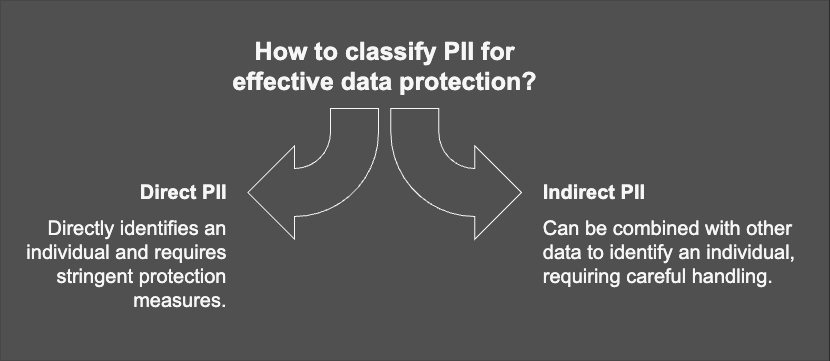A Simple Guide for Developers: How to Deal With Personal Data (PII)
As a developer, you have a big responsibility when it comes to handling personal data, also known as Personally Identifiable Information (PII).
What is PII?
PII is any information that can identify a person, either directly or indirectly.
Direct PII: Full name, phone number, email address, home address, credit card number.
Indirect PII: IP address, cookies, GPS location, or even a username.
Why is it important?
Laws like GDPR (in Europe) and CCPA (in California) require companies to protect user data. If you don’t, you could face huge fines. For example, in 2023, Meta was fined $1.3 billion for breaking data protection laws.
How to Collect PII Safely
Only Collect What You Need
Don’t ask for unnecessary information. For example, if you’re building a fitness app, you don’t need the user’s address unless it’s essential for the app’s features.
Get Clear Consent
Always ask users for permission before collecting their data. Use a pop-up or a clear message to explain why you need the data and how it will be used.
Avoid Over-Collecting
If your app only needs a name and email, don’t ask for extra details like their home address or phone number.
Keep in mind that: having no PII is always better than having PII
How to Handle PII Safely
Personal Identifiable Information (PII) is sensitive data that must be handled with care to ensure user privacy and compliance with regulations. Here’s a comprehensive guide for developers on best practices for collecting, storing, and managing PII securely.
1. Collect Only What’s Necessary
Gather only the information you truly need for your application to function. Avoid asking for unnecessary details.
Example: In a booking system, only collect the user’s name if that’s all you need, and skip collecting their date of birth or address unless absolutely required.
2. Encrypt and Anonymize Data
Protect stored and transmitted data using encryption. For added security, anonymize the data wherever possible to prevent direct identification.
Example: Instead of storing “Ahmed Hassan,” anonymize it to “User12345” and keep the mapping key in a secure location.
3. Stay Updated with Security Best Practices
Ensure all libraries, frameworks, and systems used in your application are up-to-date to mitigate vulnerabilities.
Example: Regularly check for updates to encryption tools like OpenSSL to address potential security issues.
4. Minimize Identifiable Information
Store as little identifiable data as possible. Avoid combining multiple data points that could easily reveal someone’s identity.
Example: Instead of saving a combination of name, address, and phone number, just store a unique customer ID.
5. Beware of Data Linking Risks
Even when storing data separately, ensure that combining those data sets won’t reveal personal details.
Example: Keep IP addresses in a separate database from usernames to reduce identification risks.
6. Train Your Team on Privacy Regulations
Educate your team about privacy laws like GDPR and CCPA to ensure proper handling of user data and compliance.
Example: Organize quarterly or biyearly workshops to discuss best practices for data protection and privacy compliance.
7. Prioritize Data Sensitivity Levels
Not all PII is equally sensitive. Treat sensitive information, like financial or health data, with stricter security measures.
Example: Encrypt credit card information more rigorously compared to general demographic data like age or gender.
8. Conduct Regular Risk Assessments
Periodically review how data is handled, stored, and secured to identify and address vulnerabilities.
Example: Use tools like OWASP ZAP to conduct penetration testing on your application and storage systems.
9. Isolate PII Processing
Separate environments that handle sensitive PII from your primary systems to minimize the impact of potential breaches.
Example: Use a dedicated server for PII processing that is independent of your production systems.
10. Store PII in Secure, Isolated Systems
Keep PII in environments specifically designed to handle sensitive data securely, with restricted access.
Example: Host sensitive user data on an encrypted, isolated server separate from other application components.
11. Delete Data When It’s No Longer Needed
Implement clear policies to remove outdated or unnecessary PII securely.
Example: Automatically delete a user’s data when they cancel their account or after the data has served its purpose.
12. Log and Monitor System Activities
Track all activities involving PII to quickly identify and respond to suspicious actions.
Example: Use tools to log and analyze system activity, making it easier to spot anomalies.
13. Test Your Systems Regularly
Perform regular security testing to ensure your data protection measures are effective and up-to-date.
Example: Schedule penetration tests every six to twelve months to proactively find and fix vulnerabilities.
By following these best practices, developers can protect user privacy, reduce the risk of data breaches, and build systems that inspire trust. Secure handling of PII is not just about compliance—it’s about creating a safer digital ecosystem for everyone.
Laws You Need to Know
GDPR (Europe):
Gives users the right to access, correct, or delete their data.CCPA (California):
Allows users to opt out of having their data sold.
Final Thoughts
Protecting PII isn’t just a legal requirement—it’s your duty as a developer. By following these tips, you can keep your users’ data safe and build trust in your app. Remember, the best way to protect data is to collect only what you need, store it securely, and process it responsibly.
